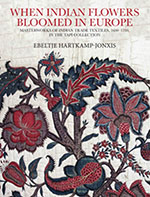Dancing peacocks, sinuous Kalpavriksha Trees of Life laden with fantastical flowers, fruits and birds…We Indian textile buffs have all feasted our eyes, either in person or in books, on the fabulous painted and printed chintz textiles that were produced on the Coromandel coast in India and their embroidered counterparts for the English and European market during the 17th and 18th century. Visits to the Museum or English stately homes and French chateaus still reveal elaborately draped curtains and bed hangings, luxurious with foliated exotic blossoms and birds, albeit now somewhat threadbare. Sometimes these exquisitely ornamented fabrics were even used instead of wallpaper, encasing an entire room, and creating an entire world of their own with their lush foliage, flora and fauna; a lush splash of exotic colour amidst the grey wet English landscape. Similar designs, floral sprigs or arabesques, on a smaller scale, were also used as dress fabric.
These hand-painted textiles, Chintzes or Palanpores as they were called, from a derivation of Chhit or from palangposh, the Hindustani word for bedspread, were ordered in thousands, reaching their apogee in the 17th and early 18th century, eventually to be displaced by mill-printed fabrics produced in England and Europe.
Just as when we talk of colonialism and Empire, the vastness and outreach of the East India Company and British Raj tends to overshadow that of the smaller but equally active French, Dutch and Portuguese trading posts and settlements, so similar textiles produced for the Dutch, Spanish and Portuguese market are less familiar, often unknown to us.


Wow, amazing blog structure! How lengthy have
you ever been running a blog for? you make
blogging glance easy. The whole glance of your site is fantastic,
let alone the content material! You can see similar here sklep
Hello! Do you know if they make any plugins to assist with SEO?
I’m trying to get my site to rank for some targeted keywords but I’m not seeing very good success.
If you know of any please share. Thanks! You can read similar article here:
Auto Approve List